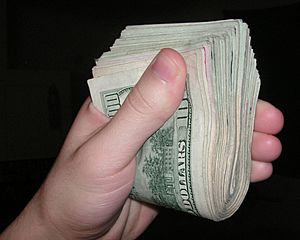Cash facts for kids

Cash is a type of money you can hold in your hand. It comes as banknotes (paper money) and coins. In business, 'cash' also means money that can be used right away. This includes money in a bank account that you can easily get. People keep cash as a backup for payments. It can also be a way to avoid problems in financial markets.
Contents
Where the Word "Cash" Comes From
The English word cash comes from South Indian languages. Words like kaasu or kasa mean money in Tamil, Kannada, Malayalam, and Telugu languages. These words have been used for over a thousand years.
Later, traders from Persia, Arab countries, and Europe started trading with Southern India. They used a changed version of the word. This happened around the time of Cyrus II and Darius I, who also made the first coins. The word then entered Latin as capsa, meaning "money box". It later became caisse in Middle French, meaning "money in hand" or "coin".
When we say "to cash" something, it means to turn it into physical money. For example, "to cash a cheque" means to get money for a cheque.
The History of Cash
The first clear proof of people using gold as money was in Egypt around 3,000 BCE. In Western Europe, after the Roman Empire fell, coins and silver were the main forms of money. This lasted for hundreds of years.
Later, merchants from Venice started using silver bars for big payments. They also began using paper bills. They would tell their banker to make payments using these bills. Other places like the Byzantine Empire also used marked silver bars for large payments.
As the world economy grew, more silver became available. Coins became larger. A standard coin for international trade appeared in the 15th century. This was the Spanish coin of 8 reales. The gold version was the Venetian ducat.
Different types of coins competed for use in markets. Rulers who made successful coins earned extra money. This was called seigniorage. It was the difference between the coin's value and the metal it was made from. Sometimes, lower-ranking nobles would copy popular coins. Their copies often had less metal, which made the original coins less popular.
As small states joined to form kingdoms, copying silver coins became less common. But gold coins, like the gold ducat and florin, were still used for trade. These coins did not have a fixed value. Their value was based on their weight.
In the early 1600s, the English East India Company made coins in England. They shipped these coins to the East. The word 'Cash' was adopted in England around this time. It came from a Sanskrit word for a weight of gold or silver.
The East India Company's coins had both Urdu and English writing. This helped people use them for trade. In 1671, the Company set up a mint in Bombay. In 1677, King Charles II approved the mint. Silver Rupees were made there.
Coins were also made for the East India Company at the Madras mint. In Bombay and Bengal, the Rupee was the main currency. But in Madras, accounts were kept using "pagodas" and other smaller units. This system lasted until 1818. Then, the Rupee became the main currency for the Company's work.
Meanwhile, paper money was being developed. At first, it was used mainly in emergencies. It became popular in European colonies. In the 18th century, important paper money was issued in places like Ceylon. John Law did important work with banknotes through the Banque Royale. However, people did not fully understand how printing too much money could cause inflation. The bank failed, and its notes became worthless.
The lessons learned from this helped the Bank of England. This bank played a key role in funding Wellington's war against French troops.
The ability to create paper money made countries responsible for managing inflation. They did this by controlling the money supply. It also meant that the value of a coin no longer had to be directly linked to the metal it contained. From 1816, most coins became token money. This means their value was set by the government, not by the metal. Some large silver and gold coins remained standard until 1927. After World War I, most standard coins disappeared.
Today, cash is a very small part of the total money supply. It is still used by people who prefer not to use other payment systems. It is also used for small, quick payments. However, electronic payment systems are increasingly replacing this role. Research shows that people use less cash as they use debit cards more. This is because stores need to give less change.
Even with electronic payments, the amount of cash in circulation is growing. The value of US dollars in circulation increased by 42% from 2007 to 2012. The value of Pound Sterling banknotes grew by 29% from 2008 to 2013. The value of the euro in circulation increased by 34% from 2008 to 2013.
What is a Cashless Society?
A cashless society is an idea for the future. It means that cash will no longer be needed. Instead, all payments will be made using electronic methods. In the UK, it is reported that one in seven people no longer carry or use cash.
Cash in Business and Money Matters
In bookkeeping and finance, 'cash' can also mean other things. It can refer to checks, money orders, cashier's checks, or traveler's checks. In these cases, 'cash' means the most liquid (easily available) type of money. These forms of money have a fixed value and can be quickly turned into physical currency. For example, if your wages are paid as "cash," it usually means by check or direct bank deposit. These are easily converted to money you can spend.
See also
 In Spanish: Dinero en efectivo para niños
In Spanish: Dinero en efectivo para niños


